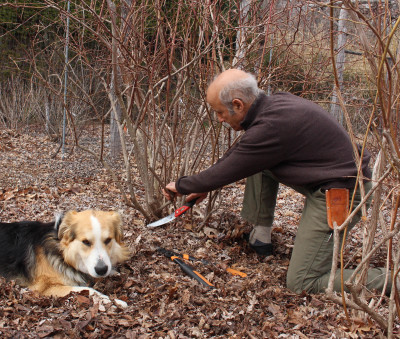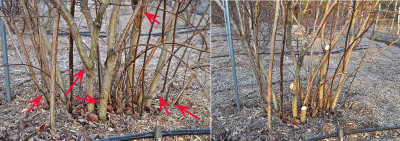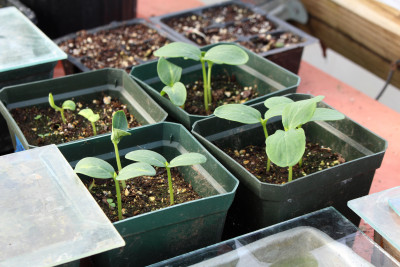THE WEATHER CALLS THE SHOTS
The Kindest Cuts
In years past, when I went outdoors this time of year, it was usually with skis strapped to my feet. Or wearing snow boots. Or snowshoes. With this snowless, warm winter, I’m mostly going outdoors these days armed with pruning shears, a lopper, and a pruning saw. Mostly, my feet trod a path to the hardy kiwifruit vines and the blueberry bushes.
At first glance, the blueberries seem nothing more than a jumbled mass of stems of various ages. How to make order out of this jumble? Quicker to answer is why go to the trouble of making order out of this jumble. The same could be asked for my lilac bush, mockorange, hazelnuts, gooseberries, and currants.

Sammy & me, pruning blueberries
Then I remind myself that my goal is to reduce the crop — yes! reduce the potential crop — so that more of the each fruit or nut bush’s resources get channeled into fewer fruits or nuts so those that remain taste better. I also prune for future years’ harvests or, for flowering bushes, future years’ flowers. And I prune to let the stems of all bushes bathe in light and air, which reduces pest problems.
Bushes are bushes because they are bushy, that is, they’re constantly growing new stems at or near ground level and never develop permanent trunks. (Except for daphne, fothergilla, witch hazel, PeeGee hydrangea, tree peony, and other plants of bushy stature with long-lived stems.) Blueberries and most other bushes, ornamental and fruiting, are pruned by a renewal method. As stems age, they grow decrepit, producing less flowers or fruits; pruning away these oldsters, right to the ground makes way for younger, replacement stems.
3 Steps, and Blueberries are Pruned
My first cuts on any of my blueberry bushes are the most dramatic ones: I cut down a couple or so of the oldest stems using a lopper or pruning saw. Blueberry stems are typically worth keeping until they are about 7 years old, or about an inch in diameter. These most dramatic cuts also remove the tallest stems in one fell swoop, so the bushes never grow so tall that the berries are out of reach.
The kind of shrub, the variety of shrub, and the previous season’s growing conditions all conspire to determine how many new stems, called suckers, grow from or near ground level. Often, it’s so many that as they mature, the bush becomes congested. So now I take pruning shears in hand, and reduce their numbers to, in the case of blueberry bushes, four or five.

Blueberry bush, before & after pruning
The finished bush then — in theory — has about 4 six-year-old stems, 4 five-year-old stems, and so on, down to 4 one-year-old stems. By this time next year, each of those stems will have moved up a year in age. I’ll remove the 4 now seven-year-old stems and excess one-year-old stems, which are those that will have grown this season.
Oh, one more step: I go over each bush with my pruning shears, removing small or dead twigs and shortening stems that are out of bounds. With 16 bushes cramped into 900 square feet, “out of bounds” is pretty close.
Early Cukes, One the Way
As so often happens in late winter and early spring, and especially this year, weather is very variable. Today was sunny and, by winter standards, balmy — perfect for crawling in among the blueberry bushes to prune them. But no need to twiddle my thumbs on sunless days raw with cold. There are seeds to be sown.
Some people spend the first part of summer hankering to bite into their first ripe tomato. Even more than tomato, I eagerly await my first fresh cucumbers and peppers. Like tomatoes, both get a head start indoors.
This year, after seeing the very early cucumber crop at Evolutionary Organics farm down the road from me, I thought I would give early cukes a try here at the farmden. On Kira, the farmer’s advice, I planted seeds a couple of weeks ago into potting soil in 4” plastic flower pots.
Cucumbers revel in heat, both for seed germination and for growing. So, after being watered, the seeded pots went onto the greenhouse’s electrically heated seed mat that’ll keep the seeds at a cozy 80°F. Seedlings are up, their roots still still in pots and still being warmed by the heating mat.
Within a couple of weeks, the cuke seedlings will start to outgrow their pots and need planting in the ground — not outdoors, though, but in the greenhouse. As I wrote, I’m hankering for a very early harvest. I’ll take the soil temperature which, I hope, will stay steadily above 65°F by then.

